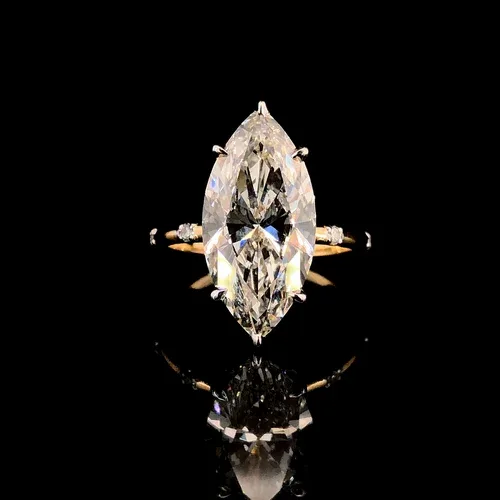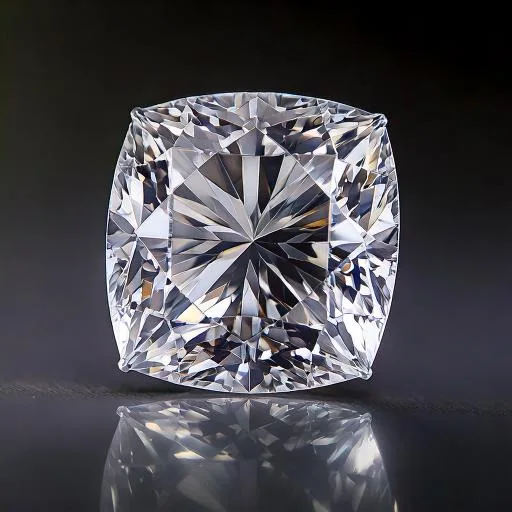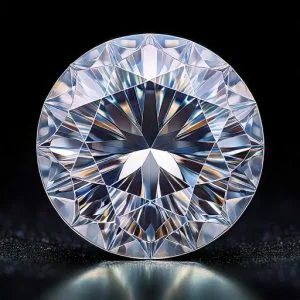A Glimmer of the Past: The Enduring Allure of Antique Diamond Cuts

In a world increasingly dominated by mass production and standardized perfection, there is a growing appreciation for the unique and the handcrafted. This sentiment extends to the world of jewelry, where modern, brilliant-cut diamonds are being challenged by the romantic and individualistic charm of antique diamond cuts. These historic gems, each with its own story and character, offer a connection to a bygone era of meticulous handcrafting and natural beauty.
Unlike the precise, mathematically perfected cuts of today, antique diamonds were fashioned by hand, guided by the natural shape of the rough stone and the cutter’s artistic eye. This process resulted in diamonds that, while often less brilliant in a modern sense, possess a distinct fire and a softer, more romantic sparkle. They were cut to shine not under the stark glare of electric light, but to dance and glimmer in the warm, flickering glow of candlelight. This intentional design gives them a unique light performance that sets them apart from their modern counterparts.
This guide will take you on a journey through the history and identifying characteristics of the most beloved antique diamond cuts, from the rustic beauty of the Rose Cut to the elegant geometry of the Asscher Cut.
The Old Mine Cut: The Grandfather of Brilliance
The Old Mine Cut is arguably the most recognizable of the antique cuts. Popular from the 18th century through the late 19th century, it is the direct ancestor of today’s cushion-cut diamond. Named for the “old mines” of Brazil and India, which were the primary sources of diamonds at the time, this cut embodies the Georgian and Victorian eras’ aesthetic.
Identifying Characteristics:
- Shape: A soft, squarish shape with rounded corners, often described as a “cushion” shape.
- Faceting: It typically has 58 facets, much like a modern round brilliant, but with a different proportioning.
- Crown: A high, often steep, crown.
- Table: A very small, flat table on top.
- Culet: A large, noticeable culet (the flat point at the bottom of the diamond), which is a key identifying feature.
- Light Performance: Known for producing bold, chunky flashes of light and a high degree of fire (the rainbow-colored light).
The slight asymmetry and individual variations of each Old Mine Cut diamond are a testament to the fact that they were shaped by a craftsman, not a machine. This gives each stone a unique personality and makes every one a truly one-of-a-kind piece of history.
The Old European Cut: A Step Toward Modernity
The Old European Cut emerged in the late 19th century and remained popular until the early 20th century. It represents a significant evolution in diamond cutting, bridging the gap between the Old Mine Cut and the modern Round Brilliant. The invention of the steam-driven bruting machine allowed cutters to create a more perfectly round outline, a departure from the cushion-like shape of the Old Mine.
Identifying Characteristics:
- Shape: A more consistently round shape than the Old Mine Cut.
- Faceting: Also has 58 facets, but they are larger, broader, and more triangular than those found in a modern brilliant.
- Crown & Table: It has a higher crown and a smaller table than a modern brilliant, but the proportions are more balanced than the Old Mine Cut.
- Culet: Like the Old Mine Cut, it has a large, visible culet, which can appear as a dark circle or spot when viewed through the table.
- Light Performance: Optimized for fire and a softer, warmer glow. The larger facets create a distinct pattern of light and dark, often described as “checkerboard” or “petal” patterns.
The Old European Cut is the diamond of the Edwardian and Art Deco eras, radiating a subtle elegance and a captivating inner fire that modern cuts simply can’t replicate.
The Rose Cut: A Glimpse into the Ancient Past
Dating back to the 16th century, the Rose Cut is one of the earliest diamond cuts. Its name comes from its resemblance to the swirling petals of a rosebud. This cut was popular for centuries, before the rise of brilliant cuts.
Identifying Characteristics:
- Shape: Typically a flat bottom with a dome-shaped top, featuring triangular facets that meet at a point.
- Faceting: Can have anywhere from 3 to 24 facets, but the key is the absence of a pavilion (the bottom part of the diamond) and a table.
- Appearance: Because it lacks a pavilion, the Rose Cut is often transparent or “see-through,” revealing the setting behind it. It offers a soft, diffused light, more of a shimmering glow than a bright sparkle.
- Profile: Very low-profile, making it an excellent choice for rings and other jewelry that might be worn daily.
The understated elegance and romantic history of the Rose Cut have led to a resurgence in its popularity in modern times, particularly for those seeking a unique and vintage-inspired engagement ring.
The Marquise Cut: A Royal Affair
The Marquise cut, also known as the “navette” cut (French for “little boat”), has a fascinating history tied to French royalty. It is said that King Louis XV commissioned a jeweler to create a diamond cut to resemble the perfectly shaped lips of his mistress, the Marquise de Pompadour.
Identifying Characteristics:
- Shape: A long, elongated oval with two pointed ends.
- Faceting: A brilliant-cut style with 56 to 58 facets, designed to maximize light return.
- Appearance: The elongated shape creates the illusion of a larger diamond and can make the wearer’s finger appear more slender.
- “Bowtie Effect”: Many Marquise cuts exhibit a “bowtie effect,” a dark shadow that can be seen across the center of the stone. This is a common characteristic and not necessarily a flaw, but a well-cut Marquise will have a minimal bowtie.
The Marquise cut’s dramatic shape and rich history make it a bold and elegant choice for those who want a diamond that truly stands out.
The Asscher Cut: The “Hall of Mirrors” Effect
The Asscher cut, developed in 1902 by the Asscher Brothers of Holland, is a step-cut diamond with a striking, geometric look. It gained immense popularity during the Art Deco era due to its clean lines and architectural aesthetic.
Identifying Characteristics:
- Shape: A square with deeply cut, beveled corners, giving it an octagonal outline.
- Faceting: Step-cut facets, which are parallel and create a stunning “hall of mirrors” effect when you look into the stone.
- Crown & Table: A high crown and a small table.
- Appearance: The step-cut faceting makes inclusions more noticeable, so a higher clarity grade (VS2 or better) is often recommended.
The Asscher cut is a testament to the precision and craftsmanship of its time. It is a sophisticated and elegant cut that appeals to those who appreciate clean, striking lines and a unique, reflective brilliance.
Why Choose an Antique Diamond?
Opting for an antique diamond cut is a choice that goes beyond mere aesthetics. It is a decision to own a piece of history, to wear a gem with a story that spans centuries. Each of these cuts, from the rustic Old Mine to the elegant Asscher, offers a distinct character that modern diamonds, for all their brilliance, cannot replicate. They were born in an era where beauty was found in the imperfect, and craftsmanship was a revered art form.
Whether you are a collector, a history buff, or simply someone who desires a truly unique and meaningful piece of jewelry, exploring the world of antique diamond cuts is a journey into a past filled with romance, artistry, and timeless beauty.
Diamond Cutting From Rough Stone to Dazzling Gem
A Journey Through the History of Diamond Cutting
Diamonds, those mesmerizing symbols of love and luxury, haven’t always possessed the dazzling brilliance we admire today. Their journey from rough, unassuming stones to the sparkling gems we cherish is a testament to human ingenuity and artistry, spanning centuries of innovation and refinement. Let’s explore the fascinating history of diamond cutting, tracing its evolution from its earliest forms to the modern techniques that unlock a diamond’s full potential.
The Dawn of Diamond Cutting
The story begins in ancient India, where diamonds were first discovered. Initially, these precious stones were revered in their natural state, believed to possess mystical powers. It wasn’t until the 14th century that rudimentary attempts at diamond cutting emerged. These early techniques primarily involved polishing the diamond’s natural facets to enhance its luster, a far cry from the intricate faceting we see today.
The Rise of Faceting
The real transformation of diamond cutting began in the 15th century with the discovery that diamond dust could be used to polish and cut diamonds. This breakthrough paved the way for the development of the first proper cutting techniques. The “point cut,” a simple pyramid shape, was an early attempt to give the diamond a more defined form.
The 16th century witnessed the birth of the “table cut,” a significant advancement that introduced a flat top, or table, to the diamond. This innovation allowed for the reflection of light within the stone, creating the first hints of the brilliance we associate with diamonds. As diamond cutting techniques progressed, the “rose cut” emerged, featuring a dome-shaped top with triangular facets, resembling a blooming rose.
 The Brilliant Cut Revolution
The Brilliant Cut Revolution
The quest for maximizing a diamond’s brilliance led to the development of the “Mazarin cut” in the mid-17th century, considered the first true brilliant cut. This design incorporated 17 facets on the crown, enhancing the diamond’s ability to capture and reflect light. The 18th century saw further refinements with the “Peruzzi cut,” boasting 33 facets on the crown, further amplifying the diamond’s sparkle.
However, the true revolution in diamond cutting occurred in the late 19th century with the introduction of the “Old European cut.” This design, with its rounded shape and 58 facets, laid the foundation for the modern brilliant cut. The advent of mechanical bruting, a technique for shaping the diamond’s girdle, enabled greater precision and consistency in cutting.
The Modern Brilliant Cut
The culmination of centuries of experimentation and innovation arrived in the early 20th century with the development of the “modern brilliant cut.” This iconic design, with its meticulously calculated 58 facets, optimizes the diamond’s brilliance, fire, and scintillation. Marcel Tolkowsky’s groundbreaking work in the early 20th century, which mathematically analyzed light behavior in diamonds, provided the scientific basis for this revolutionary cut.
Beyond the Brilliant Cut
While the modern brilliant cut remains the most popular choice, diamond cutting has continued to evolve, giving rise to a myriad of other shapes and styles. From the elegant emerald cut to the romantic heart shape, each cut offers a unique aesthetic and light performance. Advancements in technology, such as laser cutting and computer-aided design, have further expanded the possibilities of diamond cutting, allowing for intricate designs and customized shapes.
The Art and Science of Diamond Cutting
Today, diamond cutting is a delicate blend of art and science. Skilled artisans, trained in the intricacies of diamond cutting, meticulously shape each stone to maximize its beauty. Modern technology plays a crucial role, providing tools and techniques for precise cutting and polishing. The journey of a diamond from a rough stone to a dazzling gem is a testament to human ingenuity and a relentless pursuit of perfection.
The history of diamond cutting is a captivating tale of continuous innovation, driven by a desire to unlock the full potential of these precious stones. From the earliest polishing techniques to the modern brilliant cut and beyond, diamond cutting has transformed these natural wonders into objects of enduring beauty and fascination.
Diamonds come in a dazzling array of cuts, each with its own unique charm and sparkle.
Here are some of the most popular diamond cuts:
The round brilliant cut diamond. It’s a name synonymous with sparkle, fire, and enduring elegance. For generations, this iconic cut has reigned supreme, captivating hearts and adorning fingers worldwide. But what makes the round brilliant so special? This comprehensive guide delves into the intricacies of this classic cut, exploring its history, characteristics, and enduring appeal.
The Round Brilliant diamond shape has 57 facets comprising 33 facets on the crown and 25 on the pavilion. The crown facets comprise the table, 8-star facets, 8 kite facets, and 16 upper girdle facets. The pavilion facets comprise 16 lower girdle facets and 8 pavilion main facets.
A Legacy of Light: The History of the Round Brilliant
The journey to the modern round brilliant diamond is a fascinating tale of scientific advancement and meticulous craftsmanship. While early diamond cutting focused primarily on preserving weight, the pursuit of maximizing brilliance and fire led to significant innovations. The development of the bruting machine in the 15th century allowed for more precise shaping, paving the way for the eventual evolution of the brilliant cut. Over centuries, cutters experimented with different facet arrangements and proportions, culminating in the early 20th century with the emergence of the modern round brilliant. Marcel Tolkowsky’s mathematical calculations in 1919, outlining the ideal proportions for light reflection and refraction, provided the scientific foundation for optimizing the round brilliant’s brilliance.
Unlocking the Sparkle: Understanding the Round Brilliant’s Characteristics
The round brilliant’s captivating sparkle is a result of its precise geometry. Consisting of 58 facets (or sometimes slightly more, depending on the cutter’s preference), each facet plays a crucial role in how light interacts with the diamond. Light enters the diamond through the table (the largest facet on the top), is refracted and reflected internally by the other facets, and then exits through the crown (the top portion) in a dazzling display of brilliance, fire, and scintillation.
The round brilliant diamond’s enduring popularity is a testament to its timeless beauty and exceptional light performance. Its versatility makes it a perfect choice for a variety of jewelry settings, from classic solitaire engagement rings to elaborate diamond necklaces.
Whether you’re celebrating a milestone, expressing your love, or simply indulging in a piece of exquisite jewelry, the round brilliant diamond is a symbol of enduring elegance and captivating sparkle. Its brilliance continues to capture hearts and illuminate lives, solidifying its place as the king of diamond cuts.
Oval Brilliant: A graceful and elegant cut that offers brilliance similar to a round cut, but with a unique shape.
Cushion: A classic cut with a soft, rounded square or rectangular shape, known for its brilliance and vintage appeal.
Princess: A modern and popular cut with a square or rectangular shape and exceptional brilliance.
Radiant: A vibrant cut that combines the shape of an emerald cut with the brilliance of a round cut.
Heart: A romantic and symbolic cut that represents love and affection.
Pear: A teardrop-shaped cut that combines the brilliance of a round cut with the elegance of a marquise cut.
Marquise: A striking and elongated cut that maximizes carat weight and gives the illusion of larger size.

These cuts emphasize clarity and create a “hall-of-mirrors” effect.
Emerald: A classic and elegant cut with a rectangular shape and step-like facets.
Asscher: A sophisticated cut with a square shape and step-like facets, similar to an emerald cut but with a more intense sparkle.

Other Cuts:
Baguette: A small, rectangular cut often used as side stones.
Trillion: A triangular cut that can add a unique touch to jewelry designs.
When choosing a diamond cut, consider your personal style, preferences, and the setting you plan to use. Each cut has its own unique beauty and can enhance the overall look of your diamond jewelry.

 The Brilliant Cut Revolution
The Brilliant Cut Revolution